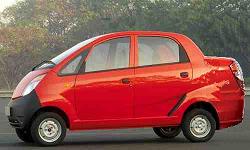The Indian auto manufacturers are probably the smartest people in the world. They really do understand the pulse of the typical Indian customer whose main obsessions are those cars that give them the highest mileage per litre of petrol/diesel, has the highest resale value, the maximum space to stuff in the family members, neighbours and their dogs.
 Once the above three main requirements are taken care of, they do not really care about the safety standards, ride quality and the driving dynamics of the vehicle. There are number of tricks that the Indian auto manufacturers use in order to fool the Indian customer who see only the peripheral issues rather than the real mechanical aspects of the vehicle.
Once the above three main requirements are taken care of, they do not really care about the safety standards, ride quality and the driving dynamics of the vehicle. There are number of tricks that the Indian auto manufacturers use in order to fool the Indian customer who see only the peripheral issues rather than the real mechanical aspects of the vehicle.
The Indian auto sector tricks
The following are some of the tricks that the auto companies in India use to offer substandard vehicles at cheaper (not always) prices to the clueless customers,
1. Market outdated technologies
India is the dump ground for unsuccessful models, dated technologies and unsafe vehicles. This technique has been followed not only by Mahindras and Marutis but even Hondas and Toyotas. Remember the first versions of Honda City in India? And the Mahindra Renault Logan is still an ancient piece.
2. Reuse excess parts that doesn’t quite fit
When Ford India introduced the Ikon model in India, they in fact, reused the steering column as it is from their left-hand-drive cars in other developing countries. And the result was different orientation of the wiper and light control lever switches. When you look at cars made by Tata, you feel that they are doing mix and match logic to create new car models.
3. Patched up designs
Well, in order to make a sedan out of a hatchback, you just add a tail from another vehicle from your stable. Tata Indigos and Fiat Petras are created like that. The latest addition to this being the Swift Dezire that’s really a ’shikhandi’ vehicle in looks and needless to say with poor driving dynamics. India’s most successful vehicle, the Maruti 800, would never pass any safety tests in any other country but would work here because it used to be a government production! It seems, this particular vehicle, doesn’t even have a proper chassis.
Some of these vehicles actually look like match boxes or a loaf of bread (Mahindra Xylo, for example)
4. Under-featured vehicles
To market a car in India, you have to take out the plush upholstery, take out good plastics and put cheap recycled ones, remove airbags and good baking technologies, remove good alloys and finally put an underpowered engine from the models two-three years back. You have to then tune the engine to give 20km/l though vehicle wouldn’t really move. But wait, since the Indians are worried about the power of their A/Cs, the air conditioner should make you freeze within 15 seconds, else you fail in the market.
5. Re-brand it
In India, unsuccessful models can be renamed and re-branded easily as long as you add some two tone cheap design, some stickers or strips, a new front grille and different looking headlights. Though, nothing is changed with the engine, you can still re-tune it and call it a XYZ-series engine and market. You may be recalled how Ford Ikon, CLX had failed in India, but Ikon Flair was an instant success. And the good old Maruti Versa is selling now under the Eeco brand.
What’s in store?
 Going by the above experiences, what we can expect from Tata soon is the sedan version of Tata Nano which would be nothing but the Tata Indigo’s boot attached to the Nano. And how can Maruti be far behind? Just like Tata, elongated and marketed the Indigo XL, now the Maruti Eeco’s newer, longer variant – the Eeeeco as shown in the picture – can be on the roads anytime now. And people will still buy them!
Going by the above experiences, what we can expect from Tata soon is the sedan version of Tata Nano which would be nothing but the Tata Indigo’s boot attached to the Nano. And how can Maruti be far behind? Just like Tata, elongated and marketed the Indigo XL, now the Maruti Eeco’s newer, longer variant – the Eeeeco as shown in the picture – can be on the roads anytime now. And people will still buy them!
Long live our auto-companies!
